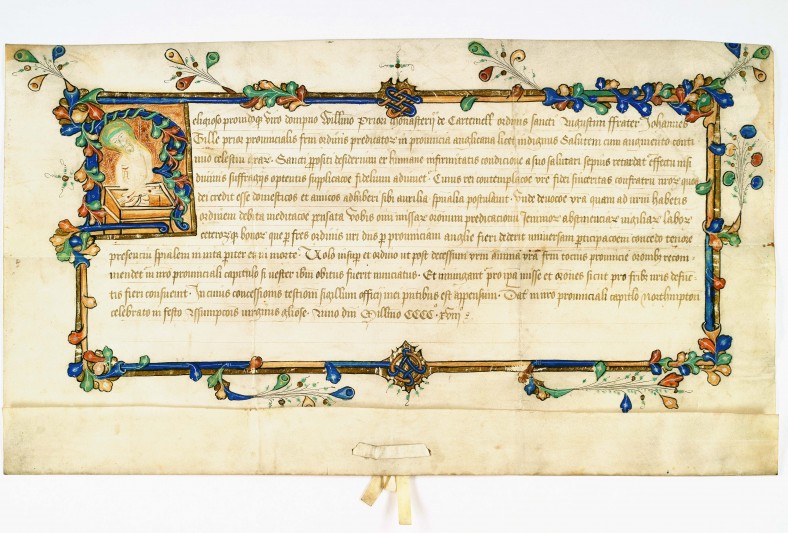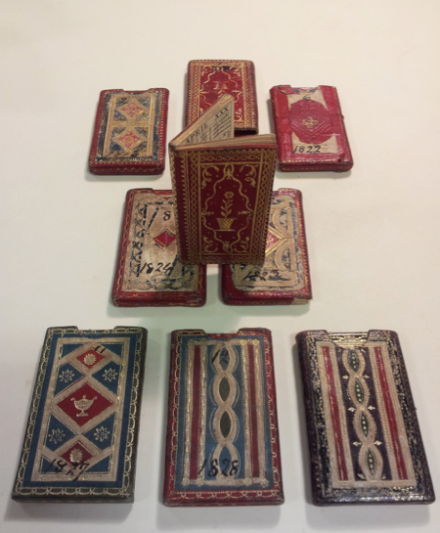Displaying 371 - 380 of 2051
Author: J R R Tolkein and E V Gordon
Item date: 1925-1938
Date acquired: 2014
Grant Value: £10,000
Item cost: £150,000
Institution: Leeds University, Brotherton Library
Town/City: Leeds
County: West Yorkshire
This collection of six letters, eleven manuscripts and two books provide unique insight into the close friendship between E. V. Gordon and J. R. R. Tolkien, formed at the University.Not only does the acquisition represent an important collection of works relating to Tolkien’s earlier academic career whilst at Leeds and Oxford, along with unpublished manuscripts that reveal the full range of his literary output, but it contains items of personal correspondence striking for their emotional candour.
The collection has been catalogued (MS 1952) and is available for consultation in the Special Collections Reading room at the Brotherton Library, University of Leeds.
Item date: 1199-1947
Date acquired: 2014
Grant Value: £15,000
Item cost: £95,000
Institution: Lancashire Record Office
Town/City: Preston
County: Lancashire
The Hulton of Hulton family and estate archive, while relating chiefly to the Bolton and Salford area of the former County Palatine of Lancaster, is also of regional and national importance. It dates from1199 to1947 and comprises over 100 boxes and trunks of documents, correspondence and papers, a good series of estate and colliery plans and a major collection of mediaeval deeds and other material, including the only known surviving document relating to the Augustinian priory at Cartmel in Cumbria.
Author: Iris Murdoch
Item date: 1957-1990s
Date acquired: 2014
Grant Value: £5,000
Item cost: £75,000
Institution: Kingston University
Town/City: London
Brigid Brophy (1929-1995) was an unconventional and experimental author of fiction and a passionate writer of non-fiction that embraced her strong political, cultural and moral views. She was also a dynamic campaigner on issues ranging from public lending rights for authors to vivisection.
Author: Tacitus [John Keats]
Item date: 1601
Date acquired: 2014
Grant Value: £5,000 from FNL's B. H. Breslauer Fund
Item cost: £43,730
Institution: Keats-Shelley House [Keats Shelley Memorial Association]
Town/City: Rome
This edition of Tacitus’s Orationes Omnes, which once belonged to John Keats, is of major importance to scholars. It brings the number of books known to have belonged to Keats to 28. It also emphasizes just how important classical culture was to the young poet, confirming the evidence of the other books (including works by Roman historians) in his possession during his life. Most of these belong to Harvard University Library or Keats House in Hampstead, the copy of Tacitus being the first Keats-owned book to join the collection in Rome.
Author: Edward
Item date: 1783
Date acquired: 2014
Grant Value: £600
Item cost: £2,700
Institution: Dr Jenner's Library
Town/City: Berkeley
County: Gloucestershire
This is an unrecorded first issue of Edward Jenner’s first publication which was printed by J. Bence of Wotton-under-Edge in 1783. Jenner was dissatisfied with the preparations of some medicines in common use and made experiments, in particular to obtain a preparation of emetic tartar which would be ‘regular in strength and uniform in operation’. The pamphlet must have been printed in the autumn of 1783, since John Hunter, the surgeon under whom Jenner had trained, acknowledged it in November.
Author: Rev. George Armstrong
Item date: c1820-1835
Date acquired: 2014
Grant Value: £6,000
Item cost: £11,400
Institution: Harris Manchester College, Oxford
Town/City: Oxford
County: Oxfordshire
The Rev. George Armstrong was initially an Anglican clergyman who became an influential Unitarian minister and this collection of his letters is largely unpublished. This makes them valuable for scholars, and, as such, a very exciting acquisition for us. The College archive reflects the history of the College, which was a Unitarian foundation, and also the history of Unitarianism and the influential people who were, and are, Unitarians, not only in the UK, but worldwide. We add to the archive as much as we can, generally through the donation of papers, and we are very grateful for this opportunity to purchase such a valuable collection.
Item date: 1817, 1818, 1822, 1823, 1824, 1827, 1828, 1831
Date acquired: 2014
Grant Value: £1,000 from FNL's B. H. Breslauer Fund
Item cost: £2,000
Institution: Guildhall Library
Town/City: London
A sequence of early nineteenth-century London Almanacks, which were essentially ephemeral and are consequently very rare indeed. The Almanacks are of importance to any major collection relating to London history, principally because the standard format includes multi-paged, and sometimes folding, engraved plates of various London landmarks, as well as a listing of the Lord Mayor and Sheriffs of that year. They are also significant examples of decorative bindings and of a tradition of printing ‘miniature books’.
Item date: 1317-1986
Date acquired: 2012
Grant Value: £4,624
Item cost: £9,248
Institution: East Sussex, Brighton and Hove Record Office
Town/City: Lewes
County: East Sussex
Robert, the son of Ralph de Alderstead of Merstham in Surrey, probably assumed the surname Pashley only on his marriage to Sarah, the heiress of an estate centred on Pashley in Ticehurst, in about 1265. His son Sir Edmund Pashley pursued a career in the common law. Among the haul is a charter of free warren on all his demesne lands in Sussex and Kent, granted to Sir Edmund in 1317; it is the earliest and most spectacular element of the collection. During the 1450s, by a process not yet fully understood but which may be illuminated by these documents, the manor passed into the hands of the Boleyn family of Hever Castle in Kent. As well as a charter of feoffment of 1455, the collection includes court rolls compiled on behalf of its lords between 1455 and 1458. In 1540 the manor was sold to the May family of Combwell in Kent, in whose hands it descended until 1733.
Author: George Mckay Brown
Item date: 20th century
Date acquired: 2012
Grant Value: £4,000
Item cost: £23,600
Institution: National Library of Scotland
Town/City: Edinburgh
The National Library of Scotland has worked since the 1950s to build an unrivalled collection of modern Scottish Literary papers. This collection of almost 100 letters from Mackay Brown to Kenna Crawford, as well as 26 manuscript poems. The letters enrich the Library’s existing George Mackay Brown collection, which includes significant literary papers and much of his extensive correspondence with a wide circle of friends, some famous and some unknown.
Author: Anna Muthesius
Item date: 1903
Date acquired: 2014
Grant Value: £2,700 from FNL's B. H. Breslauer Fund
Item cost: £3,000
Institution: Glasgow School of Art
Town/City: Glasgow
In 1903 Anna Muthesius published the influential Das Eigenkleid der Frau, regarded as a seminal text in the development of early twentieth-century dress, and particularly associated with the Artistic Dress movement. Artistic Dress describes clothing that was produced for everyday use, designed in accordance with contemporary art principles, intended to challenge fashion and considered a work of art in itself.

